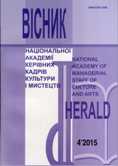ДИЗАЙН XVIII ЛІТНІХ ОЛІМПІЙСЬКИХ ІГОР У ТОКІО ЯК ФЕНОМЕН ІНТЕРНАЦІОНАЛЬНОЇ ВІЗУАЛЬНОЇ МОВИ
Graphic design for the summer games of the XVIII Olympiad in Tokyo as the phenomenon of interna-tional visual language
Author(s): Daria ShumarovaSubject(s): Visual Arts, Ethics / Practical Philosophy, Communication studies, Cultural Anthropology / Ethnology, Sports Studies
Published by: Національна академія керівних кадрів культури і мистецтв
Keywords: Olympic Games; Tokyo; modernism; international; emblem; poster; composition; mon;
Summary/Abstract: In 1964 Tokyo hosted the eighteenth Olympic Games. The 1964 Tokyo Olympic Games were a major design project directed by Japan’s top designers. The topicality of the research is determined by the fact that most of graphic design historians consider 1964 Tokyo Olympic Games as the event that presaged Japan s postwar modernization process. And this process resulted in a breakthrough in the history of graphic design. Terms such as "visual design" and "visual communications" appeared. The 1964 Summer Games was the first use of a comprehensive identity program, setting a standard for all subsequent games. Masaru Katzumie (art director) and Yusaku Kamekura (graphic designer) were the creative visionaries and team leaders behind this remarkable project. The focus of their research efforts was on an internationally standardized sign-age system based on their concern with the social significance of graphic design. Katsumi Masaru was seriously concerned about the creation of a universal visual communications system. So he identified that simple pictographs were the most efficient method of communicating to an international audience. Using a square field with a grid, the team created an extensive range of geometrically stylized pictograms. This comprehensive identity program, which included twenty multisport symbols and thirty-nine general information pictograms emphasized the athletes’ physical movements and were designed for immediate identification by a multilingual audience. This pictogram system served as a standard that influenced Lance Wyman for the 1968 Mexico City Olympics, Otl Aicher for the 1972 Munich Olympics, and Min Wang and his team for the 2008 Beijing Olympics and has become a guide for universal public visual design systems and worldwide events. Graphic design for the Tokyo 1964 Summer Olympic Games successfully combines national content, historical aspect and modernist methods. Kamekura s official poster design is a bold symmetrical vertical composition that consisted of the five Olympic rings in their original colors, the phrase "Tokyo 1964" in gold sans-serif typography, and most notably a large circle in red. Kamekura designed the emblem in consultation with typographer Hara Hiromu. The emblem had numerous applications, from the first poster to the diplomas, tickets, and medals of the Games. For some, this was the icon of, literally, the sun; for others this was a direct reference to Japan s flag, the hi-no-maru. Visual image of the Olympic games in Tokyo is considered as a way of country’s self-identification in the world and as a step towards national and cultural conscious formation in postwar Japan. The Olympics symbolize the ideal of people of all nations seeking, through sports, peaceful co-existence and respect for each other’s differences. At the same time, however, the Olympics is an event that for a time intensifies nationalism. As a result of professional teamwork and total design method the visual language of the Tokyo Olympic games depicts connections between Japanese tradition and modernity, nationalism and internationalism, past and future of the country.The visual language utilized by Tokyo 1964 Games adhered to the approach of modernism. It also encoded the visual composition of crest design, established in medieval Japan. In encoding their tradition in not directly decipherable means, postwar Japanese designers found an important resource for distinguishing their identity in the international arena, and for establishing their continuity with the past. In the years following the Olympics, their designs were recognized as instigators of an international design scene.The image of Yusaku Kamekura’s Tokyo Olympic Games Poster is widely recognized and is part of the national "memory". The vitality seen in the runners about to bolt represents the appearance of a Japan that would soon show itself as major economic power. This is the atmosphere of the times that surrounded the design work done for the 1964 Tokyo Olympic games and handed down to us. The Olympic games, with their origins in ancient Greece, are more than an international sports competition. For the 1964 Tokyo Olympics, Japan’s hope and expectation was to be part of the international community, to transcend cultural barriers and to be considered as a nation among developed nations, with modern Western values based on an idealized notion of the order of ancient Greece. Looking at the injection Japanese traditional culture into the design work for the Tokyo Olympics, it is clear that while designs were based on modern Western sources, the designers were also seeking an expression of the particular character of Japanese culture. From the time of Meiji period Japonisme, Japan had continually tried to present itself in the international community, in international world’s fairs and expositions, by consciously responding to Western understandings and expectations of Japaneseness. However, the use of the "hi-no-maru" in the design work of the Olympics shows that the designers were rather, in representing Japaneseness, strongly conscious of how the Japanese look at themselves. The design work of the 1964 Tokyo Olympic games reflects the trends of these times when Japan, positioned in the Western camp in the East-West confrontation of the Cold War, and rejecting nationalism in favor of economic growth, would look to traditional culture as a basis for a sense of commonality among the Japanese people. Analyzing the design work for the Tokyo Olympics as an expression of "Japaneseness" it is understood that the 1964 Tokyo Olympic games served to reintegrate a national consciousness among the Japanese people, to restore continuity with the past and reawaken pride in Japanese culture.
Journal: Вісник Національної академії керівних кадрів культури і мистецтв
- Issue Year: 2015
- Issue No: 4
- Page Range: 140-145
- Page Count: 6
- Language: Ukrainian

